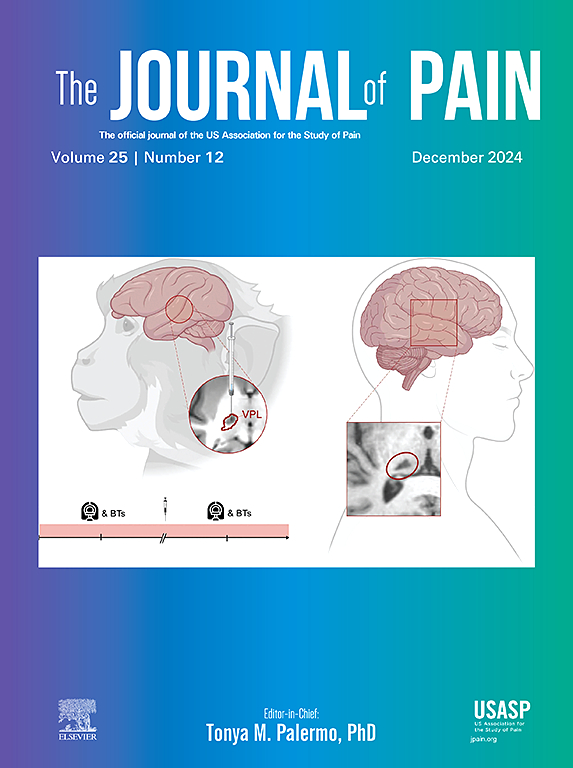How to experimentally induce fear of movement-related pain and measure psychophysiological and behavioral reactions as a proxy – A scoping review
IF 4
2区 医学
Q1 CLINICAL NEUROLOGY
引用次数: 0
Abstract
Fear can significantly increase the experienced pain intensity in individuals with chronic musculoskeletal pain and limit their ability to engage in daily activities. Fear of movement-related pain (FMRP) is commonly assessed via self-report, but research suggests measuring psychophysiological or behavioral parameters as an alternative. The objective of this scoping review was to identify and evaluate existing paradigms to induce FMRP, as well as the psychophysiological, behavioral and neural measurements used for its assessment. Experimental studies, with adult participants (≥18 years, healthy and chronic pain) observing or performing movements, were included if they used a FMRP induction paradigm or measured psychophysiological and behavioral proxies of FMRP. A total of 1883 studies were screened; 34 eligible studies were included. Paradigms inducing FMRP involved anticipated pain paired with movement (via classical or operant conditioning) or elicited pre-existing FMRP through the observation of movements potentially associated with pain. The identified studies employed various psychophysiological and behavioral measures indicating FMRP, such as response latency/duration, decision-making behavior, eyeblink startle response, and autonomic nervous system responses (e.g., skin conductance, heart rate, respiratory rate), as well as neural correlates (fMRI). fMRI studies revealed activation in fear- and pain-processing brain areas that correlated with patient-reported measurements (e.g., amygdala, hippocampus, lateral orbitofrontal cortex). Among the psychophysiological and behavioral measures displaying significant differences between fear-evoking, and neutral conditions, heart rate, respiratory response, skin conductance, and eyeblink-startle response demonstrated the largest effect sizes. In conclusion, physiological reactions can be measured during imagined, observed, or performed movements as a proxy for FMRP.
Perspective
This review provides an overview of existing paradigms to induce or elicit already conditioned FMRP in participants with chronic pain and in healthy participants. Therefore, the results of this review can inform future research projects that aim to further analyze the learning mechanisms behind and the processing of FMRP at brain level. Furthermore, measuring psychophysiological or behavioral proxies of FMRP can be beneficial not only in research settings, but also in clinical settings, to complement patient-reported outcome measures or to measure the FMRP of people with communicating issues, that are not able to complete a self-reported questionnaire.
如何通过实验诱导对运动相关疼痛的恐惧,并测量作为代理的心理生理和行为反应-范围综述。
恐惧可以显著增加慢性肌肉骨骼疼痛患者的疼痛强度,并限制他们参与日常活动的能力。对运动相关疼痛的恐惧(FMRP)通常通过自我报告来评估,但研究表明,测量心理生理或行为参数也可以作为一种替代方法。本综述的目的是识别和评估诱发FMRP的现有范式,以及用于评估FMRP的心理、生理、行为和神经测量。实验研究包括成年参与者(≥18岁,健康和慢性疼痛)观察或执行运动,如果他们使用FMRP诱导范式或测量FMRP的心理生理和行为代理。总共筛选了1883项研究;纳入34项符合条件的研究。诱发FMRP的范式包括预期疼痛与运动相结合(通过经典或操作性条件反射),或通过观察可能与疼痛相关的运动诱发预先存在的FMRP。已确定的研究采用了各种表明FMRP的心理生理和行为测量,如反应潜伏期/持续时间、决策行为、眨眼惊吓反应、自主神经系统反应(如皮肤电导、心率、呼吸频率)以及神经相关(fMRI)。功能磁共振成像研究显示,与患者报告的测量结果相关的大脑恐惧和疼痛处理区域(如杏仁核、海马体、外侧眶额皮质)被激活。在心理生理和行为测量中显示出恐惧诱发和中性条件之间的显著差异,心率、呼吸反应、皮肤电导和眨眼惊吓反应显示出最大的效应量。总之,生理反应可以在想象、观察或执行的运动中测量,作为FMRP的代理。观点:本综述概述了现有的范式,以诱导或诱发已经条件反射的FMRP在慢性疼痛参与者和健康参与者。因此,本文的研究结果对进一步分析FMRP背后的学习机制和脑层面的加工过程具有一定的指导意义。此外,测量FMRP的心理生理或行为代理不仅在研究环境中有益,而且在临床环境中也有益,补充患者报告的结果测量或测量有沟通问题的人的FMRP,这些人无法完成自我报告的问卷。
本文章由计算机程序翻译,如有差异,请以英文原文为准。
求助全文
约1分钟内获得全文
求助全文
来源期刊

Journal of Pain
医学-临床神经学
CiteScore
6.30
自引率
7.50%
发文量
441
审稿时长
42 days
期刊介绍:
The Journal of Pain publishes original articles related to all aspects of pain, including clinical and basic research, patient care, education, and health policy. Articles selected for publication in the Journal are most commonly reports of original clinical research or reports of original basic research. In addition, invited critical reviews, including meta analyses of drugs for pain management, invited commentaries on reviews, and exceptional case studies are published in the Journal. The mission of the Journal is to improve the care of patients in pain by providing a forum for clinical researchers, basic scientists, clinicians, and other health professionals to publish original research.
 求助内容:
求助内容: 应助结果提醒方式:
应助结果提醒方式:


